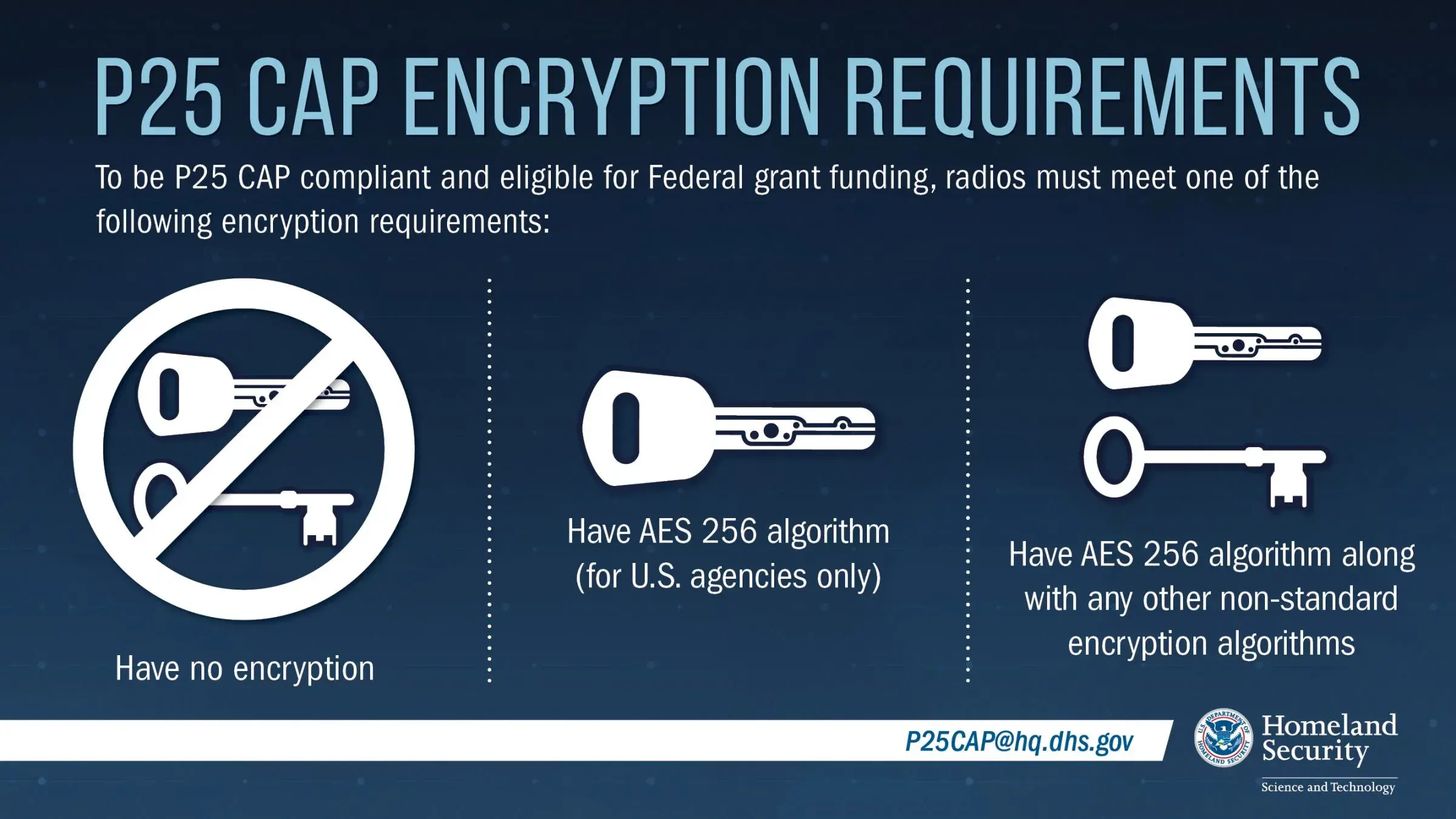
If your jurisdiction has purchased a radio, after March 2017, that was intended to be P25 CAP Compliant or that was purchased with Federal grant funds and there is any doubt whether that radio meets one of the three conditions listed to the right, Department of Homeland Security (DHS) encourages you to contact your manufacturer to confirm or take remedial action. For more information on this topic, please see the 2017 Encryption Requirements Compliance Assessment Bulletin and the posted letters on the subject supplied by the manufacturers.
Manufacturers should be cognizant that radios that do not meet DHS published Encryption Requirements are not P25 CAP compliant and may not be eligible for Federal grant funding.
The listing of equipment on the Approved (Grant-Eligible) Equipment List does not mean that all P25 features are available for the specified equipment. Some equipment may not support specific P25 features. Please request the STR (via email to P25CAP@hq.dhs.gov) to see what P25 features were tested and available in the product.
The P25 stakeholder community had frequently raised the issue of manufacturers continually providing non-P25 standard encryption algorithms that ultimately would cause interoperability issues with neighboring agencies who were using P25 standard AES 256 encryption. The key concern was the potential impact non-standard encryption has on interoperability. To sum it up, when first responders from different jurisdictions use subscribers from different vendors but are not using the standards-based and P25 CAP approved AES 256 encryption, it is very possible successful and secure communications will not occur, thereby inhibiting interoperability. However, if a subscriber unit would provide the standards-based encryption (AES 256) at a minimum in addition to non-standards based encryption, users can then always use standards-based encryption during a mutual aid scenario or situations where users have different subscriber vendors/models and have a need to operate in an encrypted mode. P25 CAP sought to reach the point where the end user, who is seeking encryption, could be assured that the subscriber unit includes user access to that AES 256 encryption algorithm.
DHS Science and Technology Directorate (S&T), with permission from each manufacturer, is making the correspondence received available. The manufacturers’ correspondence explains, in each manufacturer’s own words, the process each manufacturer is using to bring its equipment into compliance with the Encryption Requirements CAB and the process each manufacturer's customers would follow to ensure the equipment they are going to purchase or have already purchased would be or would be made P25 CAP Compliant.
SAFECOM has published resources to help practitioners understand encryption:
- Encryption in Three Minutes
- Guidelines for Encryption in Land Mobile Radio (LMR) Systems
- Best Practices for Encryption in P25 Public Safety LMR Systems
- Best Practices for Encryption in P25 Public Safety LMR Systems - Developing Methods to Improve Encrypted Interoperability in Public Safety (Fact Sheet)
- Considerations for Encryption in Public Safety Radio Systems
- Considerations for Encryption in Public Safety Radio Systems - Determining the Need for Encryption in Public Safety Radios (Fact Sheet)
- Encryption Key Management Fact Sheet
- Operational Best Practices for Encryption Key Management
- Communications Security - Protecting Critical Information, Personnel, and Operations White Paper
SAFECOM Grant Guidance is updated annually to provide current information on emergency communications policies, eligible costs, best practices and technical standards for state, local, tribal and territorial grantees investing federal funds in emergency communications projects.
This is a particularly useful resource for the best practices it provides around purchasing emergency communications capabilities, like land mobile radios. To improve interoperability across investments, grantees are strongly encouraged to ensure that digital voice systems and equipment purchased with federal grant funds are compliant with the P25 suite of standards, unless otherwise noted in a program's grant guidance. Grantees should purchase P25 compliant systems and equipment in accordance with the P25 Compliance Assessment Program.
The filters below can be used to search for P25 CAP Test documentation for equipment tested.
| Supplier Sort descending | Equipment Name | Equipment Type |
|---|---|---|
| Tait Communications | Tait Communications TP9800-TPHN0A Portable Subscriber | Project 25 Phase 1/2 Trunked Subscriber Unit |
| Tait Communications | Tait Communications TP9900-TPHN0A Portable Subscriber | Project 25 Phase 1/2 Trunked Subscriber Unit |
| Unication | Unication G4 Pager Portable Subscriber | Project 25 Phase 1 Trunked Subscriber Unit |
| Unication | Unication G5 Pager Portable Subscriber | Project 25 Phase 1 Trunked Subscriber Unit |
| Unication | Unication G5N Pager Portable Subscriber | Project 25 Phase 1 Trunked Subscriber Unit |
| Radio Activity | Radio Activity KA 160 Base Station Repeater | Project 25 Phase 1 Conventional Base Station/Repeater |
| GME | GME CM60-V25B Mobile Subscriber | Project 25 Phase 1 Trunked Subscriber Unit |
| GME | GME CM60-UL25B Mobile Subscriber | Project 25 Phase 1 Trunked Subscriber Unit |
| GME | GME CM60-U25B Mobile Subscriber | Project 25 Phase 1 Trunked Subscriber Unit |
| Leonardo Security and Information Systems | Leonardo ECOS-D RBS4000H | Project 25 Phase 1 Conventional Base Station/Repeater |
| Zetron | Zetron MT-4E Base Repeater | Project 25 Phase 1 Conventional Base Station/Repeater |
| Frequentis AG | Frequentis AG Unified P25 Gateway | Project 25 CSSI |
| Valid8 | Valid8 Conformance Test Suite | Project 25 ISSI/CSSI Test Tool |
